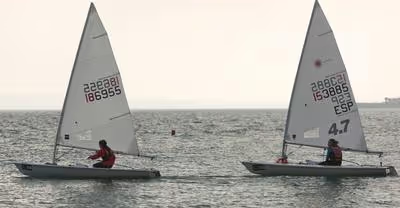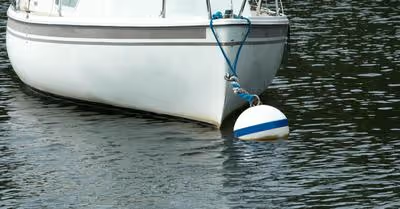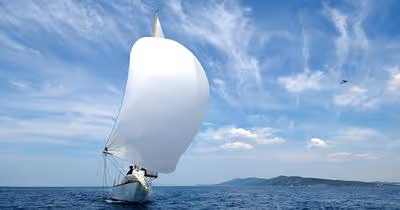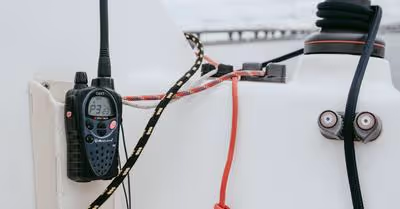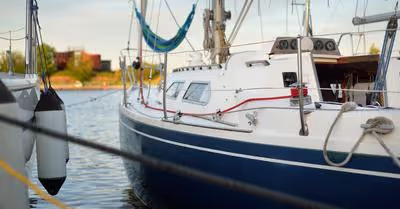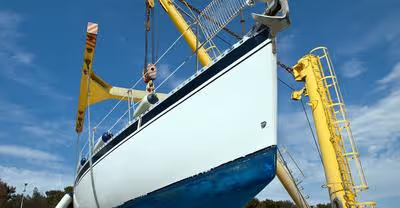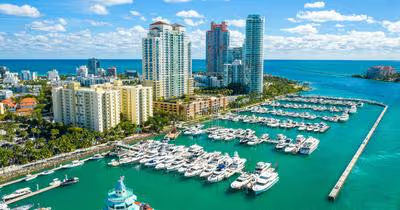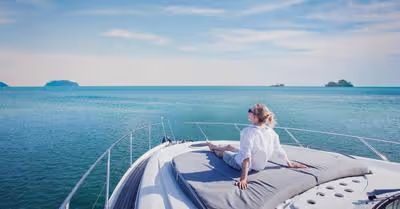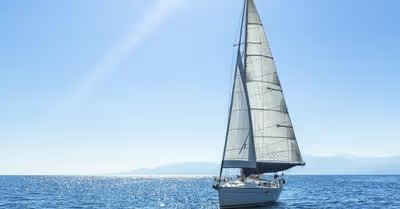Table of Contents
Measuring Sailboat Speed
Before we begin, let’s quickly take a look at the measurement of wind and sailboat speed:
In nautical terms, a sailboat’s speed is known as a knot. According to the World Sailing Speed Record Council, one knot equals 1.15 miles per hour. The knot measurement depends on the earth’s circumference, so if your sailboat is cruising at an average speed of one nautical mile per hour, it means it is traveling at a speed of one knot.
How Fast Does A Normal Sailboat Travel?
Breaking the fastest sailboat speed record and understanding the speed at which an average sailboat travels are two different things. There are several factors you need to consider when it comes to the average speed of a sailboat. The boat’s size and hull shape and the water body’s conditions significantly impact how fast a boat travels. That being said, it is extremely difficult to determine the average speed of a sailboat, but there are some approximate ranges to note that will help you determine how fast you should travel.
A monohull boat can comfortably travel at a speed of six to eight knots, whereas catamarans and trimarans usually travel at speeds above ten to fifteen knots. This is because catamarans and trimarans sit on top of the water body and displace less water.
Factors That Influence a Sailboat’s Speed
Several factors influence a sailboat’s speed. Let’s take a look:
1. Hull Type
The body of a sailboat is called the hull. It is the watertight part that skims along or rides on top of the water body. There are many different types of sailboat hulls. The hull type is one of the most crucial factors that determine a sailboat’s speed.
Here are three common types of sailboat hulls:
Monohull
A monohull is a sailboat with a single hull. It is extremely stable and somewhat impossible to capsize. It can handle severe weather conditions and provides optimal control. A monohull sailboat also has great seafaring characteristics from all directions. It travels at a speed of six to eight knots.
Catamaran (or “Cat”)
A catamaran sailboat features a hull on each side. Both hulls are equal in size. It is much faster compared to a monohull. With a catamaran, you can avoid bad weather and reach your destination in record time. The average catamaran travels at speeds above 15 knots, but this depends on the boat type.
Trimaran (or “Double-outrigger”)
A trimaran sailboat features three hulls: a narrow main hull and two smaller outrigger hulls called floats. Most trimaran sailboats are used as warships, merchant vessels, or racing and recreation boats. They can easily cruise at speeds of 15 knots to 18 knots.
2. Length and Size
The waterline on a sailboat is the part of the hull that touches the water body’s surface. It is a reference point for the maximum depth a boat can be submerged. The greater the waterline’s length, the faster a sailboat will sail. A longer waterline means it will take longer for the bow and stern waves to combine and form a single wave. Here’s how it works:
As your sailboat moves through the water, it pushes the water out of the way and creates two types of waves: bow waves at the front part of the hull and stern waves at the back part. These waves eventually meet and become one wave, which results in a trough. A trough is quite deep, preventing the sailboat from moving faster. At this point, the boat reaches its maximum speed, called the hull speed.
Some sailors are of the view that hull speed is a myth. They say that length alone cannot determine a boat’s maximum speed. Resistance and the power of the sails also play important roles in determining the speed.
3. Your Skills
Your sailboat’s features are important in determining its speed but so are your skills. Yes, you can use the engine’s power to push through in unfavorable situations, but you also need to be highly trained if you want to sail faster than the wind. With proper training and experience, you can learn how to make your boat go faster.
4. Technique and Tuning
Technique and tuning are both critical in determining the speed of your sailboat. Tuning is all about preparing your sailboat to sail easily, efficiently, and safely at high speeds. On the other hand, techniques for sailing at high speeds depend on how a sailboat is rigged. One of the basic principles taught in sailing class is sailing with the wind. This technique is also called "running before the wind." It basically means sailing in the same direction as the wind and being impelled forward.
5. Waves
Waves on a water body play a vital role in determining not just the speed of your boat but also its safety. As a sailor, you probably understand how unpredictable waves can be. They can go from calm and gentle to wild, irregular, and angry in just a few minutes. They can bully your boat and attempt to roll it over. They can also make your boat go faster or slower than it should. Waves either affect your speed positively or negatively. While calm waves are not sufficient for achieving maximum sailing speed, the right wave conditions will make your sailboat move faster.
6. Winds
The wind is the power source of a sailboat. It is the only thing that pushes the sailboat forward. It fills up the sails that are used to push the boat. Without wind, your sailboat will not move. There are two types of winds: true winds and apparent winds. Both types are crucial in moving a sailboat forward. True wind speed is the actual speed of the wind as it passes over the water’s surface. Apparent wind speed is the wind you feel while you sail. Strong winds may make a sailboat go faster than calm winds, but this also depends on the wind’s direction.
Can a Sailboat Go Faster than the Wind?
Yes! According to Science Focus, a sailboat can travel faster than the wind. This is particularly true for catamarans, ice boats, and a few monohull sailboats meant for racing.
Sailboats harness both apparent and true winds to go faster than the wind. The wind you feel on your face as you sail is called the apparent wind. As you go faster, this wind becomes stronger. Under ideal weather conditions, apparent winds are stronger than true winds. However, if you are sailing at a speed of six knots and there is a gentle breeze of six knots behind you, both apparent and true winds will cancel each other out.
So, how does this make your boat go faster than the wind? The sails of your boat feel the same wind that you feel when you, for example, ride a motorcycle with no wind whatsoever. It takes advantage of the apparent wind to go faster. The faster your boat sails, the stronger the apparent wind becomes. Strong apparent winds make your boat go even faster. It’s a cycle!
How to Make Your Sailboat Go Faster
It is possible to make a sailboat go faster. You can easily improve the speed of your sailboat in several ways. To make your sailboat go faster, you need to ensure that it is designed to attain high-speed levels. Additionally, you need to maintain your sailboat regularly so it can sail at maximum speed.
Here are five tried-and-tested ways to increase the speed of your sailboat and make it go faster:
1. Sail When It’s Windy.
As discussed earlier, the wind is the power source of a sailboat. It is only reasonable to assume that someone who wants to sail fast will set out to sail when there’s plenty of wind. So how can you tell when or where there’s more wind? A high-quality pair of polarized sunglasses can help you differentiate between windy and calm waters. If you see dark patches on the water through your sunglasses, it means it is windy in those areas. When you are out on the water, use a vantage point on the boat and scan the water body for dark patches. Sail in those areas. Your goal should be to aim for places that are the windiest. Look for open places that are free of obstacles.
2. Set the Sails for Speed.
Under normal circumstances, it is easy to sail fast, around 80% off the apparent wind, than sailing with the wind directly behind you. Trim your sails and make the wind flow over them to create a lifting effect while sailing. Doing this will allow you to propel your boat faster. Your goal should be to set the sail for the best speed. Imagine sitting in a moving vehicle with your hand out the window. Different hand positions will affect your hand differently, creating push or pull effects. The same is the case with sails.
3. Sail Straight.
Try to avoid crowds during sailing. Sailing in a crowded area will limit the wind and, thus, limit your sailing speed. You should also avoid maneuvering too much as it will only slow you down. Too much jibing is never good if you wish to sail fast. To sail fast, you should also avoid obstructions like drama. Forget about competing against other boats and try to maintain your course. This will help you aim for your optimal speed.
4. Use Proper Equipment.
It is important to ensure that your sailboat is designed to attain maximum speed. You also need to service and maintain it frequently to move at maximum speed. Ensure that the hull and foils are clean and in perfect shape. Additionally, ensure that:
- The foils do not have seaweeds or plastic bags
- The hull is in tip-top shape and can hold tension
- The sails are in the right condition
- The masts have the right stiffness
5. Make Quick Decisions.
As a sailor, you need to develop quick decision-making skills. Sometimes, weather conditions leave sailors in a dilemma that can threaten the safety of everyone on board. There will be times when you’ll be halfway out and realize there’s more wind elsewhere. You might have to decide whether to steer away or stay on the same path. If you want to sail fast, you have to make a quick call. You cannot afford to waste time thinking. Assess the gains against the losses and move!
Recent Articles



